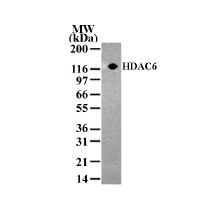HDAC6 antibody (pAb)
Host / Isotype
Rabbit / IgG
Reactivity
Human, Mouse
Applications
ChIP, WB
Cat No : 40971 40971
Synonyms
Validation Data Gallery
Product Information
| Tested Applications |
ChIP, WB
Applications Validated by Active Motif: WB: 1 - 2 ug/ml dilution For optimal results in Western blotting, primary antibody incubations should be performed at room temperature. The addition of 0.1% Tween 20 to all blocking solutions may also reduce background. Individual optimization may be required. |
| Tested Reactivity | Human, Mouse |
| Host / Isotype | Rabbit / IgG |
| Class | Polyclonal |
| Type | Antibody |
| Immunogen | This HDAC6 antibody was raised against a synthetic peptide corresponding to amino acid residues 1-16 of human HDAC6. |
| Full Name | HDAC6 antibody (pAb) |
| Synonyms | HDAC6, HDAC-6, HDAC 6, pAb, polyclonal, histone deacetylase 6, antibody, antibodies, chip, chromatin immunoprecipitation |
| Molecular weight | 134 kDa |
| GenBank accession number | NP_001308155 |
| RRID | AB_2793464 |
| Purification Method | Affinity Purified |
| Buffer | PBS containing 0.02% sodium azide. Sodium azide is highly toxic. |
| Storage | Some products may be shipped at room temperature. This will not affect their stability or performance. Avoid repeated freeze/thaw cycles by aliquoting items into single-use fractions for storage at -20°C for up to 2 years. Keep all reagents on ice when not in storage. |
Background Information
HDAC6 (Histone Deacetylase 6) is a member of the class IIb mammalian histone deacetylases (HDACs) involved in regulating chromatin structure during transcription. These enzymes catalyze the removal of acetyl groups from lysine residues of histones or many cellular proteins. Lysine N-e-acetylation is a dynamic, reversible and tightly regulated protein and histone modification that plays a major role in regulation of gene expression in various cellular functions. It consists of the transfer of an acetyl moiety from an acetyl coenzyme A to the e-amino group of a lysine residue. In vivo, acetylation is controlled by the antagonistic activities of histone acetyltransferases (HATs) and histone deacetylases (HDACs). The HDACs are grouped into four classes, on the basis of similarity to yeast counterparts: HDAC class I (HDAC1, HDAC2, HDAC3 and HDAC8), class II (HDAC4, HDAC5, HDAC6, HDAC7, 9 and 10), class III (SIRT1-7) and class IV (HDAC11). HDAC6 is a unique enzyme that harbors a full duplication of its deacetylase homology region, which appears to contribute independently to the overall activity of HDAC6 protein. alpha-tubulin and HSP90 are two known substrates of HDAC6, playing an important role in cellular mechanisms related to the microtubule network and HSP90-dependent events. HDAC6 also participates in regulating expression of a group of genes involved in the remodeling of chromatin during cell differentiation.

